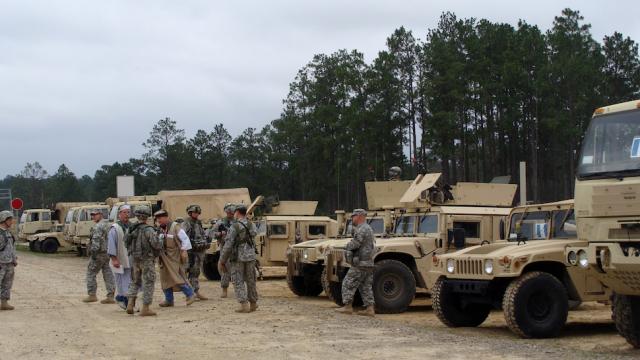The internet has changed the way most things in life work, and war is no exception. In order to keep up with the shifting landscape, the United States military is experimenting with techniques to fight the rise of online terrorism — and it sounds like they’re, uh, still figuring it out.
Fort Polk, Louisiana (image: AP)
The details come courtesy of the Atlantic‘s latest cover story, in which authors Emerson Brooking and P.W. Singer look at how the internet has changed warfare and its various appendages — from propaganda to recruitment. It’s not necessarily new stuff. ISIS, one of the story’s biggest case studies, has long been known for its frequent and effective use of social media. But the details about the military’s strategy for dealing with it all are really something.
After describing an entirely fake incident in a made-up war, Brooking and Singer explain that it’s all part of a training exercise at Fort Polk’s Joint Readiness Training Center in Louisiana:
The fort has since become the military’s training ground for new kinds of conflict — first the simulation of Cold War — and Desert Storm — style mechanised maneuvers, and then, after 9/11, the complex counterinsurgency operations of Afghanistan and Iraq. It is replete with fake villages, “opposing forces” that use the tactics of the Taliban and ISIS, and even actors playing local civilians and hard-nosed journalists.
When units deploy into the simulated battles of Kirsham, they must navigate a new addition that mimics what is happening in the real wars beyond: the smeir. Short for “Social Media Environment and Internet Replication,” smeir is a fake internet of blogs, international media outlets, and social-media accounts, all woven together to form a virtual battlefield atop the physical one. Units go out on patrol, villagers tweet about their movements, and the insurgents reshape the story to aid their recruiting — just as in real life.
Given how effectively terrorist groups have been able to commandeer social networks for their own purposes, having an opposing strategy certainly isn’t a bad idea. The problem, however, is that there… doesn’t appear to be much of a strategy.
According to The Atlantic:
There is yet no consensus on how the US military should operate in an environment saturated by smartphones and near-universal internet access. Each brigade rotating through Polk handles the experience differently: Some shift their operations as a result of online chatter; others ignore it. This experiment at Polk represents a first, small step in tackling a vast new operational challenge.
To be fair, there’s no doubt a ton of stuff we don’t know — this is the U.S. military, after all — but still, reading the words “there is yet no consensus on how the US military should operate in an environment saturated by smartphones and near-universal internet access” is a little ominous.
You can find the whole story, which is worth reading in its entirety, here.
